Human Geography: Human Settlements | Geography for UPSC CSE PDF Download
Human Geography: Human Settlements
- The study of human settlements is basic to human geography because the form of settlement in any particular region reflects a human relationship with the environment.
- A human settlement is defined as a place inhabited more or less permanently.
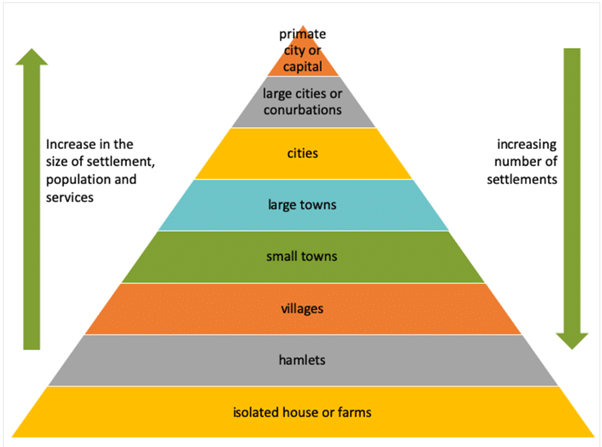
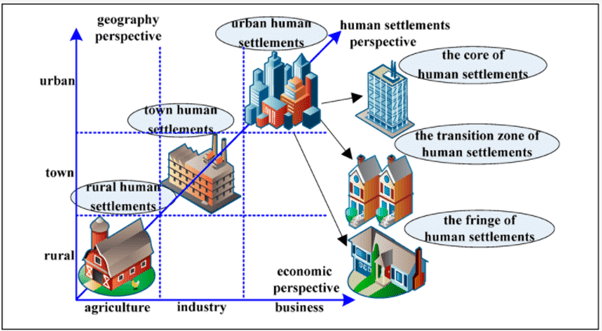

Classification of settlement
- There is no consensus on what exactly defines a village or a town.
- Although population size is an important criterion, it is not a universal criterion.
- Many villages in densely populated countries of India and China have a population exceeding that of some towns of Western Europe and the United States.
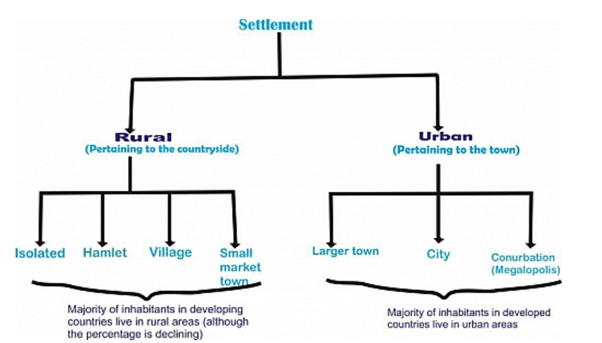
- The basic difference between towns and villages is that the people in towns are engaged in secondary and tertiary sectors, while in the villages most of the people are engaged in primary sectors.
- The census of India, 1991 defines urban settlements as “All places which have municipality, corporation, cantonment board or notified town area committee and have a minimum population of 5000 persons, at least 75 per cent of male workers are engaged in non-agricultural pursuits and a density of population of at least 400 persons per square kilometres are urban.
Types and Patterns of Settlements


- Settlements may also be classified by their shape, patterns types.
- The major types classified by shape are:
Compact or Nucleated settlements
These settlements are those in which a large number of houses are built very close to each other.
- Such settlements develop along river valleys and infertile plains.
- Communities are closely knit and share common occupations.
 Nucleated Settlement
Nucleated Settlement
Dispersed Settlements
In these settlements, houses are spaced far apart and often interspersed with fields.
- A cultural feature such as a place of worship or a market binds the settlement together.
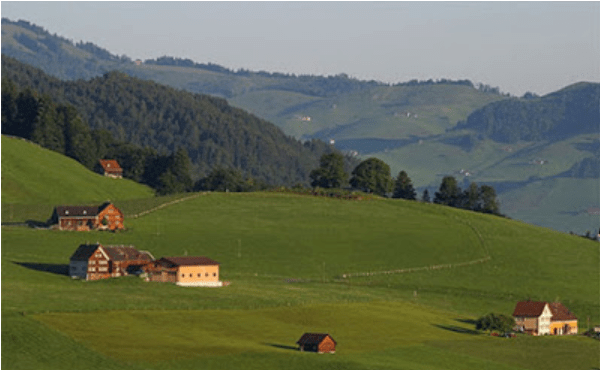 Dispersed Settlement
Dispersed Settlement
Rural Settlements
- Rural settlements are most closely and directly related to land.
- They are dominated by primary activities such as agriculture, animal husbandry, fishing etc.
- The settlements size is relatively small.
Some factors affecting the location of rural settlements are:

➤ Water Supply
Usually, rural settlements are located near water bodies such as rivers, lakes, and springs where water can be easily obtained.
- Sometimes the need for water drives people to settle in otherwise disadvantaged sites such as islands surrounded by swamps or low lying riverbanks
➤ Land
- People choose to settle near fertile lands suitable for agriculture.
- In Europe, villages grew up near rolling country avoiding swampy, low lying land while people in southeast Asia chose to live near low lying river valleys and coastal plains suited for wet rice cultivation.
- Early settlers chose plain areas with fertile soils.
➤ Upland
- Upland which is not prone to flooding was chosen to prevent damage to houses and loss of life.
- Thus, in low lying river basins people chose to settle on terraces and levees which are “drypoints”.
- In tropical countries people build their houses on stilts near marshy lands to protect themselves from flood, insects and animal pests.
➤ Building Material
- The availability of building materials – wood, stone near settlements is another advantage.
- Early villages were built in forest clearings where wood was plentiful.
- In loess areas of China, cave dwellings were important and African Savanna’s building materials were mud bricks and the Eskimos, in polar regions, use ice blocks to construct igloos.
➤ Defence
- During times of political instability, war, the hostility of neighbouring groups villages were built on defensive hills and islands.
- In Nigeria, upstanding inselbergs formed good defensive sites.
- In India most of the forts are located on higher grounds or hills.
Planned Settlements
- Sites that are not spontaneously chosen by villagers themselves, planned settlements are constructed by governments by providing shelter, water and other infrastructures on acquired lands.
- The scheme of villagization in Ethiopia and the canal colonies in the Indira Gandhi Canal command area in India are some good examples.
Rural Settlement Patterns
- Patterns of rural settlements reflect the way the houses are sited in relation to each other.
- The site of the village, the surrounding topography and terrain influence the shape and size of a village.

Rural settlements may be classified on the basis of a number of criteria:
- On the basis of setting: The main types are plain villages, plateau villages, coastal villages, forest villages and desert villages.
- On the basis of functions: There may be farming villages, fishermen’s villages, lumberjack villages, pastoral villages etc.
On the basis of forms or shapes of the settlements
- These may be a number of geometrical forms and shapes such as Linear, rectangular, circular star-like, T-shaped village, double village, cross-shaped village etc.
➤ Linear pattern
- In such settlements houses are located along a road, railway line, river, canal edge or along a levee.
➤ Rectangular pattern
- Such patterns of rural settlements are found in plain areas or wide intermontane valleys. The roads are rectangular and cut each other at right angles.
➤ Circular pattern
- Circular villages develop around lakes, tanks and sometimes the village is planned in such a way that the central part remains open and is used for keeping the animals to protect them from wild animals.
➤ Star-like pattern
- Where several roads converge, star-shaped settlements develop by the houses built along the roads.
➤ T-shaped, Y-shaped, Cross-shaped or cruciform settlements
- T-shaped settlements develop at tri-junctions of the roads while Y-shaped settlements emerge as the places where two roads converge on the third one and houses are built along these roads.
- Cruciform settlements develop on the crossroads and houses extend in all four directions.
➤ Double village
- These settlements extend on both sides of a river where there is a bridge or a ferry.
Problems of Rural Settlements
- Rural settlements in the developing countries are large in number and poorly equipped with infrastructure.
- They represent a great challenge and opportunity for planners.
- Supply of water to rural settlements in developing countries is not adequate.
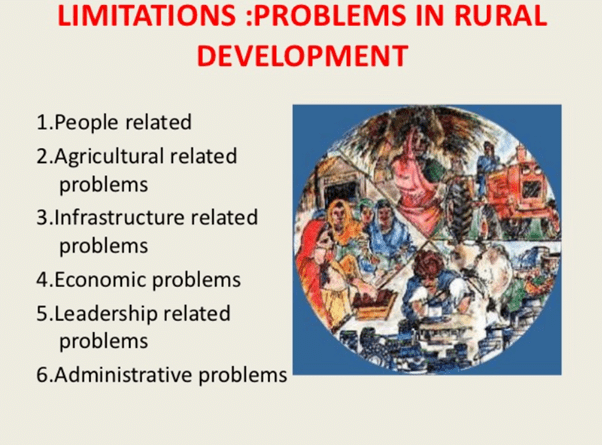
- People in villages, particularly in mountainous and arid areas have to walk long distances to fetch drinking water.
- Waterborne diseases such as cholera and jaundice tend to be common problem.
- The countries of South Asia face conditions of drought and flood very often.
- Crop cultivation sequences, in the absence of irrigation, also suffer.
- The general absence of toilet and garbage disposal facilities cause health-related problems.
- The design and use of building materials of houses vary from one ecological region to another.
- The houses made up of mud, wood and thatch, remain susceptible to damage during heavy rains and floods, and require proper maintenance every year.
- Most house designs are typically deficient in proper ventilation.
- Besides, the design of a house includes the animal shed along with its fodder store within it.
- This is purposely done to keep the domestic animals and their food properly protected from wild animals.
- Unmetalled roads and lack of modern communication network create a unique problem.
- During the rainy season, the settlements remain cut off and pose serious difficulties in providing emergency services.
- It is also difficult to provide adequate health and educational infrastructure for their large rural population.
- The problem is particularly serious where proper villagization has not taken place and houses are scattered over a large area.
Rural Settlements in India
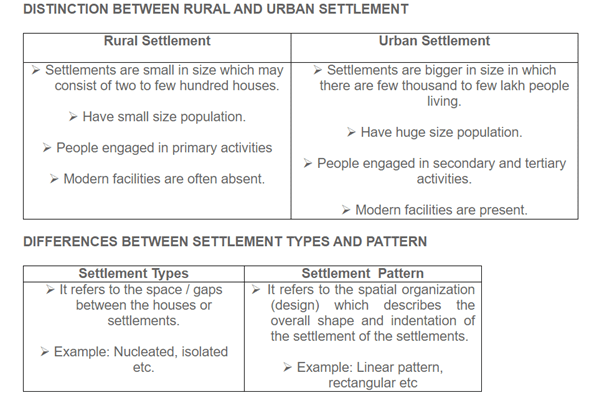
- There are various factors and conditions responsible for having different types of rural settlements in India.
- These include:
1. physical features – nature of terrain, altitude, climate and availability of water
2. cultural and ethnic factors – social structure, caste and religion
3. security factors – defence against thefts and robberies.
Rural settlements in India can broadly be put into four types
1. Clustered, agglomerated or nucleated,
2. Semi-clustered or fragmented,
3. Hamleted, and
4. Dispersed or isolated.
➤ Clustered Settlements
- The clustered rural settlement is a compact or closely built-up area of houses.
- In this type of village, the general living area is distinct and separated from the surrounding farms, barns and pastures.
- The closely built-up area and its intervening streets present some recognisable pattern or geometric shape, such as rectangular, radial, linear, etc.
- Such settlements are generally found in fertile alluvial plains and in the north-eastern states.
- Sometimes, people live in the compact village for security or defence reasons, such as in the Bundelkhand region of central India and in Nagaland.
- In Rajasthan, scarcity of water has necessitated compact settlement for maximum utilisation of available water resources.
➤ Semi-Clustered Settlements
- Semi-clustered or fragmented settlements may result from the tendency of clustering in a restricted area of dispersed settlement.
- More often such a pattern may also result from segregation or fragmentation of a large compact village.
- In this case, one or more sections of the village society choose or is forced to live a little away from the main cluster or village.
- In such cases, generally, the land-owning and dominant community occupy the central part of the main village, whereas people of lower strata of society and menial workers settle on the outer flanks of the village.
- Such settlements are widespread in the Gujarat plain and some parts of Rajasthan.
➤ Hamleted Settlements
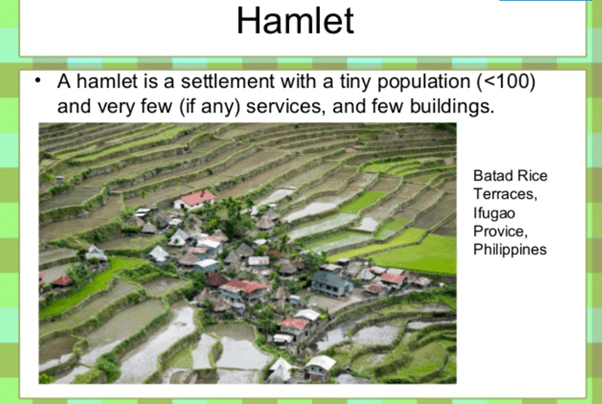
- Sometimes settlement is fragmented into several units physically separated from each other bearing a common name.
- These units are locally called Panna, para, Palli, nagla, dhani, etc. in various parts of the country.
- This segmentation of a large village is often motivated by social and ethnic factors.
- Such villages are more frequently found in the middle and lower Ganga plain, Chhattisgarh and lower valleys of the Himalayas.
➤ Dispersed Settlements
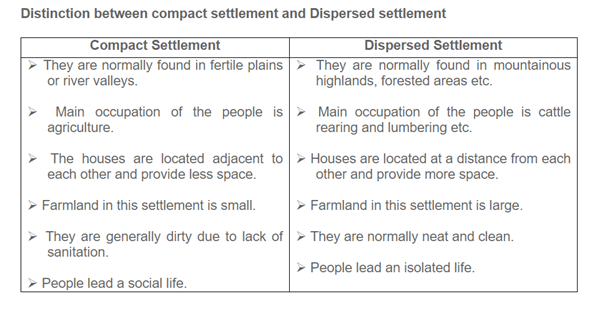
- Dispersed or isolated settlement pattern in India appears in the form of isolated huts or hamlets of few huts in remote jungles, or on small hills with farms or pasture on the slopes.
- Extreme dispersion of settlement is often caused by the extremely fragmented nature of the terrain and land resource base of habitable areas.
- Many areas of Meghalaya, Uttarakhand, Himachal Pradesh and Kerala have this type of settlement. Urban Settlements.
- Rapid urban growth is a recent phenomenon.
- Until recent times, few settlements reached a population size of more than a few thousand inhabitants.
- The first urban settlement to reach a population of one million was the city of London by around. A.D. 1810.
- By 1982 approximately 175 cities in the world had crossed the one million population mark.
- Presently 54 per cent of the world’s population lives in urban settlements compared to only 3 per cent in the year 1800.
Classification of Urban Settlements
- Some of the common bases of classification are the size of the population, occupational structure and administrative setup.
Population Size
- It is an important criterion used by most countries to define urban areas.
- The lower limit of the population size for a settlement to be designated as urban is 1,500 in Colombia, 2,000 in Argentina and Portugal, 2,500 in the U.S.A. and Thailand, 5,000 in India and 30,000 in Japan.
- Besides the size of the population, a density of 400 persons per sq km and a share of non-agricultural workers are taken into consideration in India.
- In Denmark, Sweden and Finland, all places with a population size of 250 persons are called urban.
- The minimum population for a city is 300 in Iceland, whereas, in Canada and Venezuela, it is 1,000 persons. Occupational Structure.
- In some countries, such as India, the major economic activities in addition to the size of the population in designating a settlement as urban are also taken as a criterion.
- Similarly, in Italy, a settlement is called urban, if more than 50 per cent of its economically productive population is engaged in non-agricultural pursuits.
- India has set this criterion at 75 per cent.
Administration
- The administrative setup is a criterion for classifying a settlement as urban in some countries.
- For example, in India, a settlement of any size is classified as urban, if it has a municipality, Cantonment Board or Notified Area Council.
- Similarly, in Latin American countries, such as Brazil and Bolivia, any administrative centre is considered urban irrespective of its population size.
Location
- Location of urban centres is examined with reference to their function.
- Strategic towns require sites offering natural defence; mining towns require the presence of economically valuable minerals; industrial towns generally need local energy supplies or raw materials; tourist centres require attractive scenery, or a marine beach, a spring with medicinal water or historical relics, ports require a harbour etc.
- Locations of the earliest urban settlements were based on the availability of water, building materials and fertile land.
- Today, while these considerations still remain valid, modern technology plays a significant role in locating urban settlements far away from the source of these materials.
- Piped water can be supplied to a distant settlement, the building material can be transported from long distances.
- Apart from the site, the situation plays an important role in the expansion of towns.
Functions of Urban Centres
- The earliest towns were centres of administration, trade, industry, defence and religious importance.
- The significance of defence and religion as differentiating functions has declined in general, but other functions have entered the list.
- Today, several new functions, such as recreational, residential, transport, mining, manufacturing and most recent activities related to information technology are carried on in specialised towns.
- Some of these functions do not necessarily require the urban centre to have any fundamental relationship with their neighbouring rural areas.
- In spite of towns performing multiple functions we refer to their dominant function.
- For example, we think of Sheffield as an industrial city, London as a port city, Chandigarh as an administrative city and so on.
- Large cities have a rather greater diversity of functions.
- Besides, all cities are dynamic and over a period of time may develop new functions.
- Most of the early nineteenth-century fishing ports in England have now developed tourism.
- Many of the old market towns are now known for manufacturing activities.
- Towns and cities are classified into the following categories.
Administrative Towns
- National capitals, which house the administrative offices of central governments, such as New Delhi, Canberra, Beijing, Addis Ababa, Washington D.C., and London etc. are called administrative towns.
- Provincial (sub-national) towns can also have administrative functions, for example, Victoria (British Columbia), Albany (New York), Chennai (Tamil Nadu). Trading and Commercial Towns 50.
- Agricultural market towns, such as, Winnipeg and Kansas City; banking and financial centres like Frankfurt and Amsterdam; large inland centres like Manchester and St Louis; and transport nodes such as Lahore, Baghdad and Agra have been important trading centres.
Cultural Towns
- Places of pilgrimage, such as Jerusalem, Mecca, Jagannath Puri and Varanasi etc.
- These urban centres are of great religious importance.
- Additional functions which the cities perform are health and recreation (Miami and Panaji), industrial (Pittsburgh and Jamshedpur), mining and quarrying (Broken Hill and Dhanbad) and transport (Singapore and Mughal Sarai).
- Urbanisation means the increase in the proportion population of a country who live in urban areas.
- The most important cause of urbanisation is rural-urban migration.
- During the late 1990s some 20 to 30 million people were leaving the countryside every year and moving into towns and cities.
- Developed countries experienced rapid urbanisation during the nineteenth century.
- Developing counties experienced rapid urbanisation during the second half of the twentieth century.
Classification of Towns on The Basis Of Forms

- An urban settlement may be linear, square, star or crescent-shaped.
- In fact, the form of the settlement, architecture and style of buildings and other structures are an outcome of its historical and cultural traditions.
- Towns and cities of developed and developing countries reflect marked differences in planning and development.
- While most cities in developed countries are planned, most urban settlements of developing countries have evolved historically with irregular shapes.
- For example, Chandigarh and Canberra are planned cities, while a smaller town in India has evolved historically from walled cities to large urban sprawls.
Addis Ababa (The New Flower)
The name of the Ethiopian capital Addis Ababa, as the name indicates (AddisNew, Ababa-Flower) is a ‘new’ city that was established in 1878.
- The whole city is located on a hill-valley topography.
- The road pattern bears the influence of the local topography.
- The roads radiate from the govt headquarters roundabouts.
- Types of Urban Settlements: Depending on the size and the services available and functions rendered, urban centres are designated as a town, city, million cities, conurbation, megalopolis.
- Town: The concept of ‘town’ can best be understood with reference to ‘village’.
- Population size is not the only criterion.
- Functional contrasts between towns and villages may not always be clear-cut, but specific functions such as manufacturing, retail and wholesale trade, and professional services exist in towns.
City
- A city may be regarded as a leading town, which has outstripped its local or regional rivals.
- Cities are much larger than towns and have a greater number of economic functions.
- They tend to have transport terminals, major financial institutions and regional administrative offices.
- When the population crosses the one million mark it is designated as a million city.
- Conurbation: The term conurbation applies to a large area of urban development that resulted from the merging of originally separate towns or cities.
- Greater London, Manchester, Chicago and Tokyo are examples.
Million City
- The number of million cities in the world has been increasing as never before.
- London reached the million mark in 1800, followed by Paris in 1850, New York in 1860, and by 1950 there were around 80 such cities.
- In 2016, there were 512 cities with at least 1 million inhabitants globally.
- By 2030, a projected 662 cities will have at least 1 million residents.
Megalopolis
- Megalopolis signifies ‘super-metropolitan’ region extending, as the union of conurbations.
- The urban landscape stretching from Boston in the north to south of Washington in the U.S.A. is the best-known example of a megalopolis.
Distribution of Mega Cities
- A megacity or megalopolis is a general term for cities together with their suburbs with a population of more than 10 million people.
- New York was the first to attain the status of a megacity by 1950 with a total population of about 12.5 million. The number of megacities is now 31.
- The number of megacities has increased in the developing countries during the last 50 years vis-à-vis the developed countries.
What is a Healthy City?
World Health Organisation (WHO) suggests that, among other things, a ‘healthy city must have:
1. A ’Clean’ and ‘Safe’ environment.
2. Meets the ‘Basic Needs’ of ‘All’ its inhabitants.
3. Involves the ‘Community’ in local government.
4. Provides easily accessible ‘Health’ service.
Problems of Urban Settlements
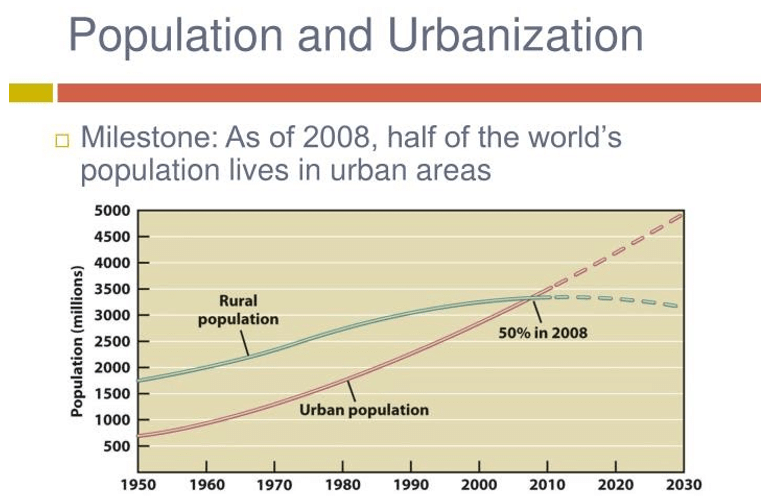
- People flock to cities to avail themselves of employment opportunities and civic amenities.
- Since most cities in developing countries are unplanned, it creates severe congestion.
- Shortage of housing, vertical expansion and growth of slums are characteristic features of modern cities of developing countries.
- In many cities an increasing proportion of the population lives in substandard housing, e.g. slums and squatter settlements.
- In most million-plus cities in India, one in four inhabitants lives in illegal settlements, which are growing twice as fast as the rest of the cities.
- Even in the Asia Pacific countries, around 60 per cent of the urban population lives in squatter settlements.
Economic Problems
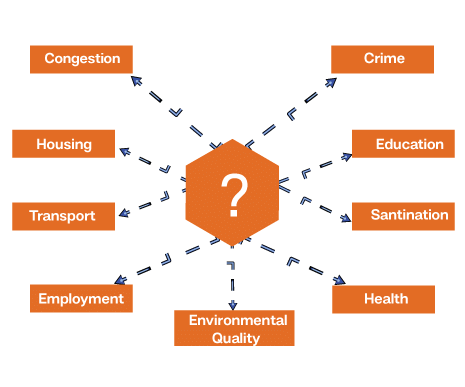
- The decreasing employment opportunities in the rural, as well as smaller urban areas of the developing countries, consistently push the population to the urban areas.
- The enormous migrant population generates a pool of unskilled and semi-skilled labour force, which is already saturated in urban areas.
- Socio-cultural Problems: Cities in developing countries suffer from several social ills.
- Insufficient financial resources fail to create adequate social infrastructure catering to the basic needs of the huge population.
- The available educational and health facilities remain beyond the reach of the urban poor.
- Health indices also, present a gloomy picture in cities of developing countries.
- Lack of employment and education tends to aggravate the crime rates.
- Male selective migration to the urban areas distorts the sex ratio in these cities.
Environmental Problems
- The large urban population in developing countries not only uses but also disposes of a huge quantity of water and all types of waste materials.
- An improper sewerage system creates unhealthy conditions.
- Massive use of traditional fuel in the domestic, as well as the industrial sector, severely pollutes the air.
- The domestic and industrial wastes are either let into the general sewerages or dumped without treatment at unspecified locations.
- Huge concrete structures erected to accommodate the population and economy play a very conducive role to create heat islands.
- Urban Heat Island: Local Heat Build up in areas of high population density.
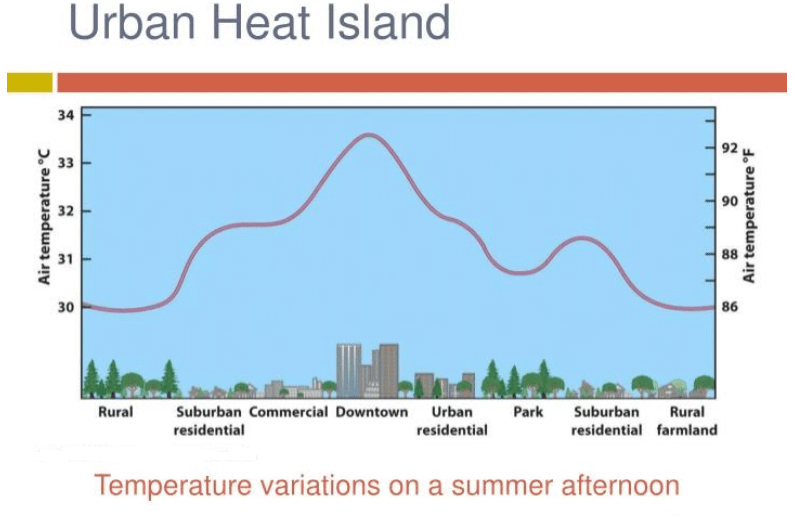
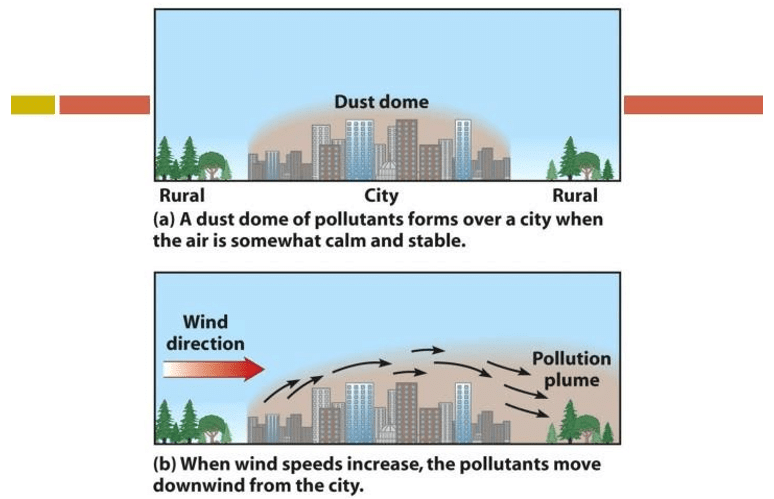
|
175 videos|472 docs|197 tests
|
FAQs on Human Geography: Human Settlements - Geography for UPSC CSE
| 1. What is the classification of human settlements? |  |
| 2. What are planned settlements? |  |
| 3. How are rural settlements patterned? |  |
| 4. What are the problems faced by rural settlements? |  |
| 5. How are urban settlements classified? |  |

|
Explore Courses for UPSC exam
|

|


















